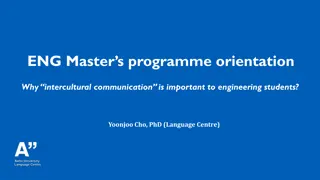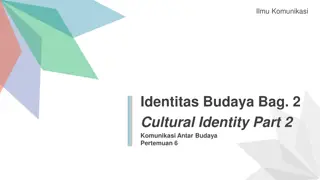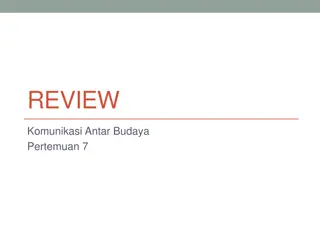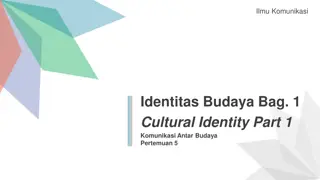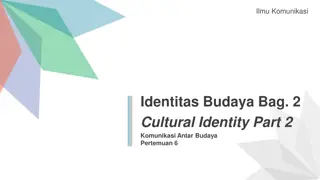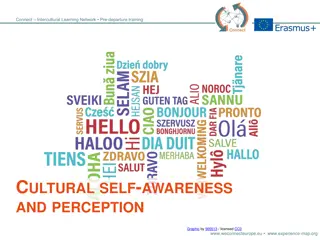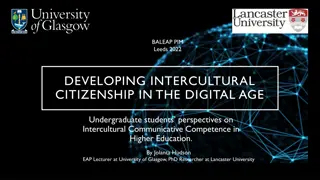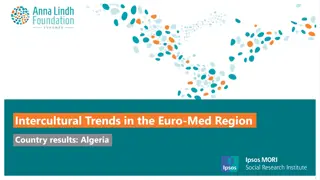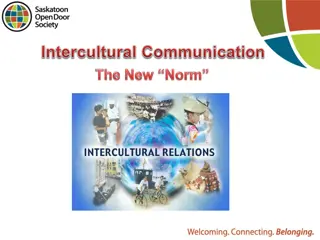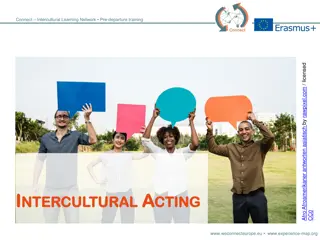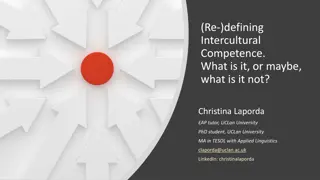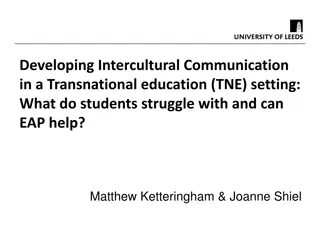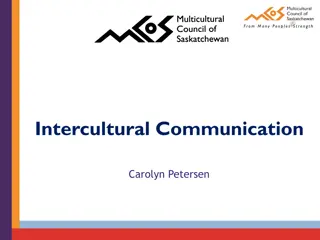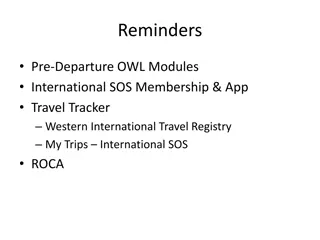Understanding Intercultural Communication: Developing an Action Theory
Explore the development of an action theory for intercultural communication, focusing on evidence, applications, and politics. Delve into the social action grammar of culture, observations, evidence, and models, as well as characteristics of narratives and found discourses. Discover the nuances of intercultural communication through narratives and ideal types presented in the study. The narrative of Jenna, Bekka, and Malee offers insights from diverse backgrounds, shedding light on negotiating a grammar of culture.
Download Presentation

Please find below an Image/Link to download the presentation.
The content on the website is provided AS IS for your information and personal use only. It may not be sold, licensed, or shared on other websites without obtaining consent from the author. Download presentation by click this link. If you encounter any issues during the download, it is possible that the publisher has removed the file from their server.
E N D
Presentation Transcript
Developing an action theory for intercultural communication: evidence, applications and politics Adrian Holliday
Social action grammar of culture Action inhibited by structures Particular cultural products Particular social & political structures Underlying universal cultural processes Artefacts: Art, literature etc., cultural practices Personal trajectories: Cultural resources: Education, language, religion, tradition etc. Statements about culture: Discourses of and about culture , ideology, prejudice, outward expression of Self & Other Small culture formation: Constructing and engaging with social rules and relationships Family, ancestry, peers, profession etc. Global position & politics: Constructing Self & Other Negotiating action
Observation, evidence and model Ethnographic disciplines Developing the grammar Submission, emergence, personal knowledge Reconstructions Connections & complexities that take on a life of their own Everyday life Caution about being too specific Conversations, interviews, behaviour Other research
Characteristics of the narratives o Detail o Several characters, one or more informing others, different voices o Unexpected oppositions, juxtapositions, conflict o Open to interpretation, unresolved o Statements about culture and discourses o Not data cautious rationalisation of data Far more than what individuals say Cannot be caught in traditional interviews Kubota (2003). Unfinished knowledge: the story of Barbara. College ESL 10/1-2: 84-92.
Found discourses Ideal types Ways of talking about things which influence how we think about the world Normalised, between the lines o Essentialist culture and language Our behaviour and values are determined by national cultures and their languages o Critical cosmopolitan We can find ourselves in other cultural environments Cultural travel, contestation and innovation o West as steward The West is looking after the rest of the world o West versus the rest , Third space , Liberal multicultural
Sample narrative Jenna, Bekka and Malee Holliday, A. R. (2013). Understanding intercultural communication: negotiating a grammar of culture. London: Routledge, p.70 This is based on a number of conversations with students and colleagues from a variety of backgrounds, and on research into the experiences of British and international students in British and Australian universities Caruana & Spurling (2006). The internationalisation of UK higher education: a review of selected material. The Higher Education Academy. Clifford & Montgomery (Eds.). (2011). Moving towards internationalisation of the curriculum for global citizenship in Higher Education. OCSLD & CICIN (Centre for International Curriculum Inquiry & Networking), Oxford Brookes University Grimshaw(2010). Stereotypes as cultural capital: international students negotiating identities in British HE. Paper presented at the British Association of Applied Linguistics Annual Conference: Applied Linguistics: Global and Local, University of Aberdeen. Harrison & Peacock (2009). Interactions in the international classroom: the UK perspective. In Jones (Ed.), Internationalisation and the student voice: higher education perspectives. Routledge: 125-42. Jones (Ed.). (2009). Internationalisation and the student voice: higher education perspectives. Routledge. Montgomery (2010). Understanding the international student. Palgrave Macmillan. Ryan & Louie (2007). False dichotomy? 'Western' and 'Confucian' concepts of scholarship and learning. Educational Philosophy & Theory 39/4: 404-17. Ryan & Viete (2009). Respectful interactions: learning with international students in the English-speaking academy. Teaching in Higher Education 14/3: 303-14.
Meeting Bekka Jenna felt a sense of liberation after her discussions with Malee and her friend from school. She had found it hard to make friends with local students and was surprised when Bekka began to take notice of her and wanted to have coffee after class. She wondered if it had anything to do with her having joined in a classroom discussion and talked about how at home there was a tradition of voting out figures of authority in extreme circumstances. Using cultural resources to engage with culture
Being on time When they had coffee Bekka said that she was interested in what Jenna had been talking about and very surprised because she had heard that her culture was very hierarchical and authoritarian. Essentialist culture and language discourse Global position and politics Contesting statements about culture Jenna replied that she had heard so many things about the local culture which did not seem to be true, like people always being on time. She had noticed so many students turning up late. Bekka said that from what she had read this would be explained by Jenna s culture being collectivist while hers was individualist. Beginnings of a critical cosmopolitan discourse Defensive response
Respecting freedom This response puzzled Jenna because the point she was making was that there was room for variation in both cultures. Bekka explained that individualist cultures were different because they were based on valuing self-expression and determination and therefore there could be a lot more variation of behaviour and people were free to not be on time if they wished, and that that would be respected. Essentialist culture and language discourse on the defence Global position and politics Cultural contestation As time went on Jenna felt that her relationship with Bekka soured. The more Jenna felt she was coming out and asserting herself in front of local students and tutors, the more Bekka went on about how different their cultures were. Taking ownership
Being Westernised Then, in one of their coffee sessions, Bekka announced that she had noticed a remarkable change in Jenna that she really had become so Westernised. Global position and politics Jennawasn t sure how to take this. She felt that Bekka was congratulating her; but Malee was horrified when she mentioned this to her and said that the people here just couldn t stand the idea that foreigners could be as expressive, independent and critical as they were without having learnt it from them and having become assimilated into their ways. The critical insider friend West as steward discourse
Bekka Malee The right to behave as one wishes Knowledge of collectivism and individualism Cultural resources My culture also values the right for individuals to be what they want Western culture values the right for individuals to be what they want Global position & politics People from other cultures have and practice these values they must have become Westernised and be like us We do not have to be Westernised or assimilated to have these values Statements about culture My culture is individualist and your culture is collectivist, authoritarian and hierarchical My culture cannot be defined and pinned down in this way Underlying universal cultural processes Constructing cultural explanations to deal with high stake conflict Imagining assimilation Resisting assimilation
Observations The essentialist culture and language discourse provides the shared language for the encounter Bekka is unaware of her West as steward discourse The critical cosmopolitan discourse is acted but not spoken Assimilation therefore seems a harmless obvious Jenna and Malee are more critical than Bekka She doesn t understand the patronising nature of Westernisation even though its a loss of culture Almost everything that Jenna and Malee think and do remains unrecognised Underlying universal cultural processes can both encourage cultural travel and increase prejudice
Cosmopolitan complexity o Individuals can subscribe to, be ambivalent about, or reject several discourses at the same time different discourses at different times for all sorts of reasons without realising or very consciously (not necessarily calling them discourses ) o Governed by cultural resources and global position & politics o By means of underlying universal cultural processes
Social action model Social structure Social action Culture Culture Politics, ideology, religion, economy etc
The notion of linguaculture When I as a Dane move around the world, I tend to build on my Danish linguaculture, when I speak English, French or German. I therefore contribute to the flow of Danish linguaculture across languages. (Risager 2011: 110) o Small and personal
Multiple worlds Established world Dominant Centre- Western discourse Emergent world The margins Normalised ( neutral ) descriptions of national cultures All the things the imagined world cannot imagine The prejudice created by the structures and discourses of the imagined world Imagined world An idealised Self and demonised Other Dealing with the discourses of prejudice Structures and discourses to imagine, dominate and help the Other
Research themes Possibly: o How people draw on existing cultural experience and structures o How this experience becomes the resource for engaging with the new o How (e.g.) linguaculture is carried into new languages The role of discourses o How they perpetuate stereotypes, myths, prejudices, values o The strategies underpinning everyday statements about culture o The complexities of truth and fiction
References Delanty, Wodak, et al (Eds.). (2008). Identity, belonging and migration. Liverpool University Press. Dervin (2011). A plea for change in research on intercultural discourses: A liquid approach to the study of the acculturation of Chinese students. Journal of Multicultural Discourses 6/1: 37-52. Hall (1991). Old and new identities, old and new ethnicities. In King (Ed.), Culture, globalization and the world-system. Palgrave: 40-68. Holliday (2007). Doing & writing qualitative research. Sage. (2011). Intercultural communication & ideology. Sage. (2013). Understanding intercultural communication: negotiating a grammar of culture. Routledge. Honarbin-Holliday (2009).Becoming visible in Iran: women in contemporary Iranian society. I B Tauris. Kumaravadivelu (2007).Cultural globalization & language education. Yale University Press. Risager (2011). Linguaculture and transnationality. In Jackson (Ed.), Routledge handbook of language & intercultural communication. Routledge: 101-5.




